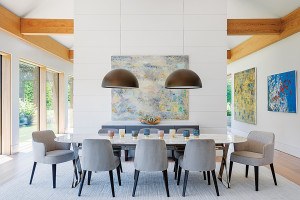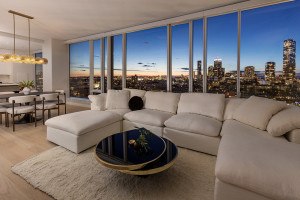Q&A: Zhanna Drogobetsky
Fresh off the opening of her latest furniture showroom, Zhanna Drogobetsky—owner of the South End’s Casa Design Living, Casa Design Outdoor, Molteni&C Dada Boston, and the new Casa Design Contract—looks back on 20 years in Boston’s design industry.

Drogobetsky rests easy on a Gio Ponti–designed armchair inside Molteni&C Dada Boston. / Photograph by Cody O’Loughlin, hair and makeup by Paula Voisembert/team
This has been a big year for you.
It all started with Molteni&C and Casa Design flooding in October 2016. It made me rethink the entire positioning of the stores. Molteni was pretty new at the time, only a year and a half old. It was growing and growing, and I felt like we needed to give it a better position. And then the person who had Casa Design Outdoor’s current space called me one day and said, “Hey, I’m thinking about getting out of my lease early, do you want to see the space?” And when we walked in, [my showroom manager] Erik looked at me and said, “All right, we’re taking this, right?” It was just love at first sight, so we ended up signing the lease right away. And then, another space that I’d always wanted became available just one week later. So, we ended up taking that, too [for our new hospitality-and-contract furniture store, Casa Design Contract]. In four weeks, we have three new spots. I do believe that things happen at the right time for the right reasons. I am a big believer in that.
You have a great story about graduating from Northeastern and receiving the keys to your first furniture store, in Brookline, from your parents. What was that moment like?
Coming out of school, you’re not sure what to expect because everything has been really safe for you. And we had challenges in that [Brookline] space, being in the basement. They were challenges I was excited about, though, because going through Northeastern’s co-op program, I knew that “corporate America” was not for me. Taking a vision and making it happen has always been very satisfactory. So having a vision for that first furniture store was the beginning. And then, of course, it kept growing. My best friend—we’ve been best friends for 35 years—calls this my “two-year itch.” She says, “It’s funny because, if I can clock you in, every two years there’s something going on!” And it’s really true. I feel like if you just stay put and don’t follow what’s going on in the world, your business is not going to succeed.
Where does your love for design come from?
I’ve always loved fashion, so this was the next best thing. Interior design and furniture are very intuitive for me. I have a vision when I walk into a client’s house or when I go to Milan for furniture shopping. I just see what’s going to sell. I can understand what the next item should be in our showroom, because that’s what Boston is going to want.
What are you looking for when scouting new pieces? What gets you excited about something?
That’s a really good question, because getting excited after 20 years of doing this gets harder, for sure. Innovation gets me excited. Last year, a new closet system came out with integrated lighting and glass doors that were partially see-through when lit up. These types of things, with new designs and materials and fun textures, are what I get excited about because clients are smarter now. They think about durability and budget because they have the Internet to research all of it.
How have you seen design in Boston change?
When I started 20 years ago, [my store] was sort of a niche in the market because [it was] modern and medium-end back then. But now modern has become the new “it.” That’s where most styles are heading, even when you look at new architecture in Boston, like Millennium Tower. The designers we work with—even some of the traditional ones—are moving toward that, too, because they’re trying to match the architecture within the spaces they’re working on. That’s what clients are requesting.
Boston’s design scene is very different from what you’d find in New York or L.A. What do we have that other cities don’t?
Tradition. Also Boston has maybe five or six modern showrooms versus New York, which has lots and lots. The selection is more refined here. But I think that’s why we wanted to bring Molteni, a mono-brand, into Boston [without] running it under [the Casa Design] umbrella. It’s my first mono-brand ever. I always had multiple-brand showrooms because, of course, it’s easier to sell lots of things versus one. But I feel so strongly about Molteni because it’s a complete design brand: You can get a kitchen, a closet, a sofa, a bedroom. You can go to one brand and have a completely done home. So I thought that was an important add-on for me.
Which pieces in your showrooms are you coveting these days?
My favorites right now are Molteni’s “Paul” sofa and “Domino” tables, which are really fun to layer. We’ve been creating atmospheres that allow for movement depending on how clients entertain. It’s one of the first questions we ask when we do projects because your home is for you, but it’s also for when people come over. We talk about this when we do kitchen design, for example.
It’s really as much about lifestyle as it is about how something actually looks.
Yes, I always stress that. It really is about lifestyle. I tell my clients, “I’m not going to live in your house. It’s important to create a space that you’re comfortable in.”
You’ve said that you’re the “Queen of No.”
Yes, I am. I just know from all these years that clients come back and regret things. I stop that by saying, “Why don’t we think about this? Let’s make sure it looks good in your house. Let’s make sure that the colors are right for you.” Intuition is great, but it should also be followed by some thinking.
Pinterest. Friend or foe?
We find it helpful. Most of my [retail] clients give me Pinterest boards now. Even designers are creating them, so by the time they come to me, it’s really easy for me to select items because I already have a sense of what their style is. I do question their judgment, though, which is why I’m the Queen of No. Sometimes you see a Pinterest board that has so many interesting things on it. I advise against buying too many of those statement pieces because if everything speaks, you won’t be able to hear anything.
Are there any furniture trends or styles that you wish would just go away?
Velvet is really hot right now. You look at all my showrooms, and they’re full of it! But I can imagine in six months I won’t be able to look at velvet again. Velvet could go, and I would be okay with it. I’m actually excited about most of the other trends. I love the golden, warm tones that are coming in. I love mixing and matching. It’s really fun.
What’s next for you?
We’re very deep into talks about opening another mono-brand. We’re also working on this new idea of “mingle nights” where we’re going to host different design firms [in the showrooms], serve food and alcohol, and let the firms mingle with each other—because there’s so much movement in the design industry.
Did you ever imagine that this is what your life would look like?
I always knew that I was going to own my own business, but I never dreamed that it would grow like it has. I feel very honored to be where I am. The clients that I’ve had over the last 20 years, the architects and designers, we’ve formed friendships. Half the people who attended my last birthday party were interior designers that I’ve worked with. I still have the same clients and work with the same people from 20 years ago. So that’s been a great ride.


